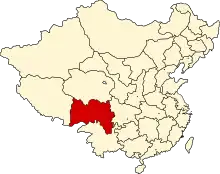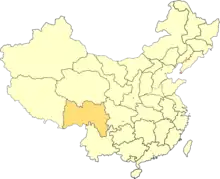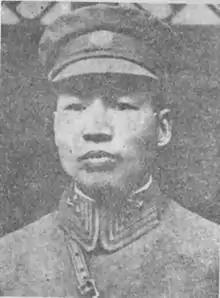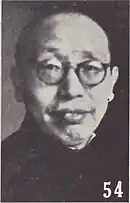| Xikang Province 西康省 | |||||||||||
|---|---|---|---|---|---|---|---|---|---|---|---|
| 1939–1950 | |||||||||||
 Xikang Province in the Republic of China | |||||||||||
| Capital | Kangding (1912–1931) Ba'an (1931–1935) Ya'an (1935–1936) Kangding (1935–1949) Xichang (1949–1950) | ||||||||||
| Area | |||||||||||
• Estimate | 451,521 km2 (174,333 sq mi) | ||||||||||
| Population | |||||||||||
• Estimate | 1,748,458 | ||||||||||
| Historical era | 20th century | ||||||||||
• Established | 1939 | ||||||||||
• Fall of Xichang | 27 March 1950 | ||||||||||
• Disestablished | 1950 | ||||||||||
| |||||||||||
| Today part of | China India | ||||||||||
| Xikang Province 西康省 | |||||||||||
|---|---|---|---|---|---|---|---|---|---|---|---|
| 1950–1955 | |||||||||||
 Xikang Province (orange) in the People's Republic of China | |||||||||||
| Capital | Kangding (1950–1951) Ya'an (1951–1955) | ||||||||||
| Area | |||||||||||
• 1953 | 451,521 km2 (174,333 sq mi) | ||||||||||
| Population | |||||||||||
• 1953 | 3,381,064 | ||||||||||
| Historical era | 20th century | ||||||||||
• Established | 1950 | ||||||||||
• Disestablished | 1955 | ||||||||||
| |||||||||||
| Today part of | China India | ||||||||||
Xikang (also Sikang or Hsikang) was a nominal province[1] formed by the Republic of China in 1939 on the initiative of prominent Sichuan warlord Liu Wenhui[2] and retained by the early People's Republic of China. The former territory of Xikang is now divided between the Tibet Autonomous Region and Sichuan province.
The idea behind Xikang province was to form a single unified province for the entire Kham region under direct Chinese administration, in effect annexing the western Kham region that was then under Tibetan control. Kham was entirely populated by Tibetan people called Khampas. The then-independent Tibet controlled the portion of Kham west of the Upper Yangtze River.[3] The nominal Xikang province also included in the south the Assam Himalayan region (Arunachal Pradesh) that Tibet had recognised as a part of British India by the 1914 McMahon Line agreement.[4] The eastern part of the province was inhabited by a number of different ethnic groups, such as Han Chinese, Yi, Qiang people and Tibetan, then known as Chuanbian (川邊), a special administrative region of the Republic of China. In 1939, it became the new Xikang province with the additional territories belonging to Tibetan and British control added in. After the People's Republic of China invaded and occupied Tibet, the earlier nationalist imagination of Xikang came to fruition.
The provincial capital of Xikang was Kangding from 1939 to 1951 and Ya'an from 1951 to 1955. The province had a population of 3.4 million in 1954.[5]
History


In 1910, general Zhao Erfeng occupied Kham region, destroyed a few monasteries and killed over 1000 lamas. Later on, he proclaimed this territory as a new Chinese province subsequently known as Xikang.
Following the Wuchang Uprising in October 1911, which led to the downfall of the Qing dynasty, the region was established as the Chuanbian Special Administrative District (川邊特別行政區) by the newly founded Republic of China.
In June 1930, eastern Kham (later Xikang) was invaded by the army of Tibet, precipitating the Sino-Tibetan War. With the district locked in internal struggles, no reinforcements were sent to support the Sichuanese troops stationed here. As a result, the Tibetan army captured Garzê and Xinlong Counties without encountering much resistance. When a negotiated ceasefire failed, Tibetan forces expanded the war, attempting to capture parts of southern Qinghai province. In March 1932, their force invaded Qinghai but was defeated by the local Hui warlord Ma Bufang in July, who routed the Tibetan army and drove it back to this district.
The Hui army captured counties that had fallen into the hands of the Tibetan army since 1919. Their victories threatened the supply lines of the Tibetan forces in Garzê and Xinlong. As a result, part of the Tibetan army was forced to withdraw.
In 1932 Liu Wenhui in cooperation with the Qinghai army, sent out a brigade to attack the Tibetan troops in Garzê and Xinlong, eventually occupying them, Dêgê and other counties east of the Jinshajiang River. The 1934 Khamba Rebellion led by the Pandatsang family broke out against the Tibetan government in Lhasa. The Khampa revolutionary leader Pandatsang Rapga was involved.
In January 1939, the Chuanbian Special Administrative District officially became a province of the Republic, the Hsikang Province. Kesang Tsering was sent by the Chinese to Batang to take control of Sikang, where he formed a local government. He was sent there for the purpose of propagating the Three Principles of the People to the Khampa.[6]
In 1950, following the defeat of the Kuomintang by the Chinese Communist Party in the Chinese Civil War, Xikang was split along the Yangtze into Sikang to the east and a separate Chamdo Territory (昌都地区) to the west. Chamdo was merged into Tibet Autonomous Region in 1965. The rest of Hsikang was merged into Sichuan in 1955.
Administrative divisions
1939–1950
| Name | Administrative Seat | Traditional Chinese | Subdivisions | Comments |
|---|---|---|---|---|
| First Administrative Circuit | Kangding County | 第一行政督察區 | 4 counties, 1 bureau | Later the Xikang Province Tibetan Autonomous Region |
| Second Administrative Circuit | Yingjing County | 第二行政督察區 | 7 counties | Later the Ya'an Division |
| Third Administrative Circuit | Xichang County | 第三行政督察區 | 9 counties, 3 bureaus | Later the XIchang Division |
| Fourth Administrative Circuit | Garzê County | 第四行政督察區 | 15 counties | Later the Xikang Province Tibetan Autonomous Region |
| Fifth Administrative Circuit | — | 第五行政督察區 | 13 counties | Chamdo Region; de facto controlled by Tibet |
1950–1955
| Name | Simplified Chinese | Hanyu Pinyin | Subdivisions |
|---|---|---|---|
| Ya'an (1951–1955) | 雅安市 | Yǎ'ān shì | 1 city Ya'an |
| Ya'an Division | 雅安专区 | Yǎ'ān Zhuānqū | 8 counties Ya'an (1950–1951), Baoxing, Lushan, Tianquan, Yingjing, Hanyuan, Mingshan (1951–1955), Shimian (1951–1955) |
| Xichang Division | 西昌专区 | Xīchāng Zhuānqū | 13 counties Xichang, Yanyuan, Yanbian, Huili, Ningnan, Dechang, Zhaojue (1950–1952), Yuexi, Mianning, Jinkang (1952–1955), Muli (1952–1955), Miyi (1952–1955), Huidong 3 bureaus Puge (1950–1952), Ningdong (1950–1952), Luoning (1950–1952) |
| Xikang Province Tibetan Autonomous Region | 西康省藏族自治区 | Xīkāng Shěng Zàngzú Zìzhìqū | 20 counties direct controlled Kangding, Danba, Qianning, Yajiang, Luding, Jiulong 1 bureau Jintang Ganzi Regional Office (1951–1955) Litang Regional Office (1951–1955) |
| Liangshan Yi Autonomous Region (1952–1955) | 凉山彝族自治区 | Liángshān Yízú Zìzhìqū | 8 counties Zhaojue, Puge, Ningdong, Xide, Butuo, Jinyang, Meigu, Puxiong |
List of governors
Kuomintang (Nationalist) Chinese Communist Party
Chairperson of the Provincial Government
| No. | Portrait | Name (Birth–Death) |
Term of office | Political party | |
|---|---|---|---|---|---|
| 1 |  |
Liu Wenhui 劉文輝 Liú Wénhuī (1895–1976) |
1 January 1939 | 9 December 1949 | Kuomintang |
| Defected to the Communists. | |||||
| 2 |  |
Ho Kuo-kuang 賀國光 Hè Guóguāng (1885–1969) |
25 December 1949 | March 1950 | Kuomintang |
| Fled to Taiwan via Haikou after fall of Xichang. | |||||
Xikang CPC Party Committee Secretary
| No. | Portrait | Name (Birth–Death) |
Term of office | Political party | |
|---|---|---|---|---|---|
| 1 | Liao Zhigao 廖志高 Liào Zhìgāo (1913–2000) |
1950 | 1955 | Chinese Communist Party | |
| Province abolished. | |||||
Xikang People's Government Chairperson (Governor after January 1955)
| No. | Portrait | Name (Birth–Death) |
Term of office | Political party | |
|---|---|---|---|---|---|
| 1 | Liao Zhigao 廖志高 Liào Zhìgāo (1913–2000) |
26 April 1950 | September 1955 | Chinese Communist Party | |
| Province abolished. | |||||
See also
References
- ↑ Lin, Boundary, sovereignty and imagination (2004), p. 30: "Despite its almost entirely illusory nature, the so-called Xikang province was officially sketched out by Chinese map-makers, from whom it came to be known nation-wide.
- ↑ Yajun Mo, "The New Frontier: Zhuang Xueben and Xikang Province", in "Chinese History in Geographical Perspective", edited by Yongtao Du and Jeff Kyong-McClain, p. 124, Lexington Books, 2013
- ↑ Lin, Boundary, sovereignty and imagination (2004), p. 29: "According to the Kuomintang, the boundary of this new Xikang province encompassed, not only part of the southwestern province of Sichuan that was then dominated by the Han Chinese warlord Liu Wenhui, but also a huge portion of the ethnographic Tibetan area west of the Upper Yangtze River that was then effectively administered by the autonomous Tibetan government."
- ↑ Lin, Boundary, sovereignty and imagination (2004), p. 29: "In addition, the newly carved provincial boundary also extended deep into the Tibetan-Assam tribal territory, including areas south of the theoretically existing McMahon Line that had been signed away to British India by Lhasa in 1914."
- ↑ "第一次全国人口普查公报". Archived from the original on August 5, 2009. Retrieved November 17, 2009.
- ↑ Hsiao-ting Lin (2010). Modern China's ethnic frontiers: a journey to the west. Vol. 67 of Routledge studies in the modern history of Asia (illustrated ed.). Taylor & Francis. p. 27. ISBN 978-0-415-58264-3. Retrieved 2011-12-27.
area and spreading Sun Yat-sen's Three People's Principle among the Tibetan and Khampa minorities, Kesang Tsering set up a field headquarters in Batang (Pa'an). There he appointed his own Xikang provincial government staff and issued an
Bibliography
- Lin, Hsiao-ting (2004), "Boundary, sovereignty, and imagination: Reconsidering the frontier disputes between British India and Republican China, 1914–47", The Journal of Imperial and Commonwealth History, 32 (3): 25–47, doi:10.1080/0308653042000279650, S2CID 159560382
- Lin, Hsiao-ting (2010). Modern China's Ethnic Frontiers: A journey to the west. Taylor & Francis. ISBN 978-0-415-58264-3.